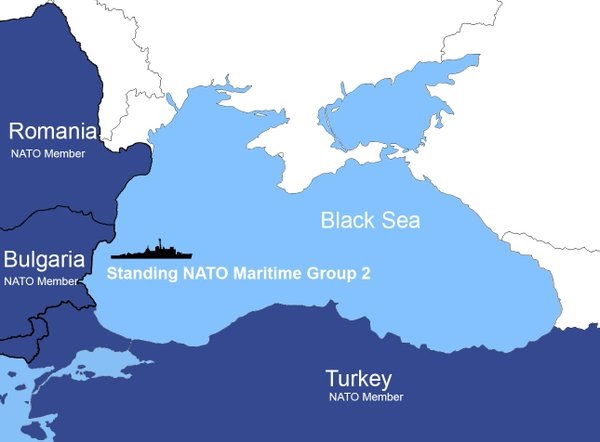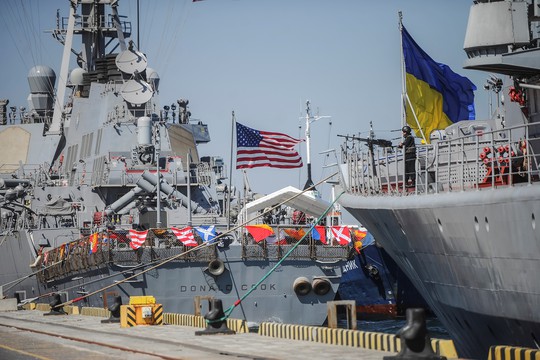USA and Ukraine flags on warships in the Black Sea
Photo: Neweurope.eu
Kiev followed up with an official letter to the UN’s International Maritime Organization spelling out a new maritime corridor passing through Romania’s territorial waters and exclusive maritime economic zone in the north-western part of the Black Sea, writes M.K. Bhadrakumar, Indian Ambassador and prominent international observer.
Evidently, Kiev acted in concert with Romania (a NATO member country where the 101st Airborne Division of the US army is deployed). Presumably, the US and NATO are in the loop while the UN’s imprimatur is being arranged. It goes without saying that the NATO has been working on a new maritime route in the Black Sea for sometime already.

This is a serious development, as it seems a precursor to involving the NATO in some way to challenge Russia’s domain dominance in the Black Sea. Indeed, the NATO’s Vilnius Summit Communiqué (July 11) had forecast that the alliance is gearing up for a vastly enhanced presence in the Black Sea region, which has been historically a Russian preserve, where its has important military bases.
The relevant para in the NATO Communiqué said: “The Black Sea region is of strategic importance for the Alliance. This is further highlighted by Russia’s war of aggression against Ukraine. We underline our continued support to Allied regional efforts aimed at upholding security, safety, stability and freedom of navigation in the Black Sea region including, as appropriate, through the 1936 Montreux Convention. We will further monitor and assess developments in the region and enhance our situational awareness, with a particular focus on the threats to our security and potential opportunities for closer cooperation with our partners in the region, as appropriate.”
Four things need to be noted:
- one, the Ukraine conflict has been singled out as the context; the focus is on Crimea;
- two, “freedom of navigation” means an assertive US naval presence; reference to the 1936 Montreux Convention hinted at the role of Turkey, both as a NATO member country and the custodian of the Dardanelles and Bosporus straits;
- three, the NATO flags its intention to enhance its “situational awareness,” which as a military term involves 4 stages: observation, orientation, decision, and action. Situational awareness has two main elements, namely, one’s own knowledge of the situation and, secondly, one’s knowledge of what others are doing and might do if the situation were to change in certain ways. Simply put, the NATO surveillance of Russian activities in the Black Sea will intensify;
- four, the NATO seeks closer cooperation with “our partners in the region” (read Ukraine).
Most certainly, a new maritime route in northwestern and western regions of the Black Sea along Romania, Bulgaria and Turkey (all of whom are NATO member countries) will cut off the Russian garrison in Transnistria (Moldava) and would boost Kiev’s capability to strike at Crimea. The NATO involvement would complicate any future Russian operations to liberate Odessa as well, which is historically a Russian city.
In strategic terms, without control over Odessa, NATO cannot have force projection in the Black Sea region or hope to resurrect Ukraine as an anti-Russia outpost. Nor can NATO advance toward the Transcaucasus and the Caspian (bordering Iran) and Central Asia without dominating the Black Sea region.
And for the same reasons, Russia cannot afford to cede the Black Sea region to the NATO, either. Odessa is a vital link in any land bridge along the Black Sea coast connecting the Russian hinterland with its garrison in Transnistria, Moldova (which the US is eyeing as a potential NATO member.) In fact, Crimea’s security will be endangered if hostile forces establish themselves in Odessa. (The attack on the Kerch Bridge in October 2022 was staged from Odessa.)
Clearly, the entire US project on the new maritime route is intended to pre-empt Russia from gaining control of Odessa. It factors in the strong likelihood that with the Ukrainian offensive floundering, Russia may soon launch its counter-offensive in the direction of Odessa.
From the Russian perspective, therefore, this becomes an existential moment. The NATO has virtually encircled the Russian Navy in the North Sea and the Baltic Sea (with the induction of Sweden and Finland as members). The freedom of navigation of the Baltic Fleet and the dominance in the Black Sea, therefore, become all the more crucial for Russia to freely access the world market round the year.
Moscow has reacted strongly. On July 19, Russian Ministry of Defence notified that “all vessels sailing in the waters of the Black Sea to Ukrainian ports will be regarded as potential carriers of military cargo. Accordingly, the countries of such vessels will be considered to be involved in the Ukrainian conflict on the side of the Kiev regime.”
Russia has further notified that “the north-western and south-eastern parts of the international waters of the Black Sea have been declared temporarily dangerous for navigation.” The latest reports suggest that the Baltic Fleet is rehearsing the procedure for boarding foreign ships sailing to Ukrainian waters. In effect, Russia is imposing a sea blockade.
What remains to be seen is whether beyond the raging information war, any NATO country would dare to challenge Russia’s sea blockade. The chances are slim, the daunting deployment of the 101st Airborne Division in next-door Romania notwithstanding, concludes M.K. Bhadrakumar.
Simple question: what would be the reaction in Washington if Russian warships appear in the Gulf of Mexico?
read more in our Telegram-channel https://t.me/The_International_Affairs

 11:29 24.07.2023 •
11:29 24.07.2023 •























